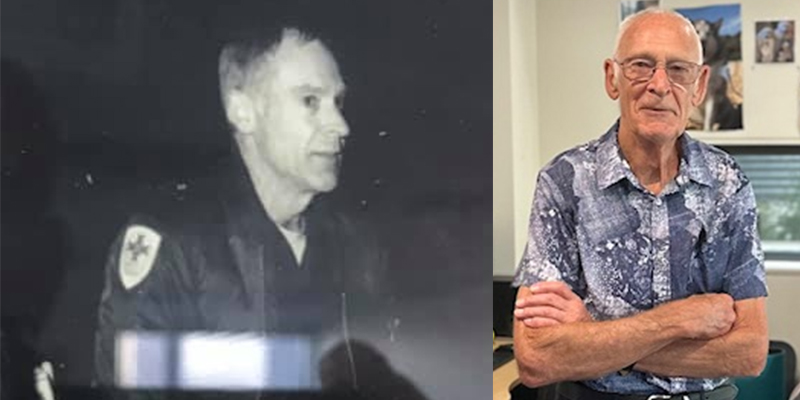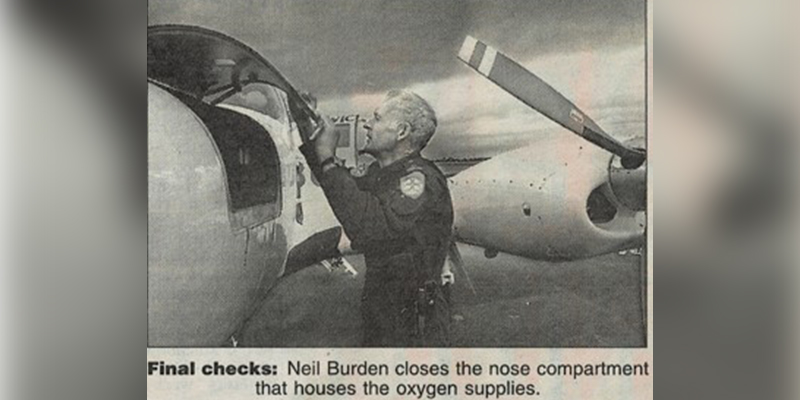Neil hangs up the uniform after 48 years of service
February 21, 2024in Community News
When Neil Burden became a paramedic “by chance” in 1975, he never could have imagined he’d spend almost five decades working in some of Victoria’s most challenging paramedic roles.
Neil, 81, recently retired from Ambulance Victoria following a remarkable 48-year career which saw him work across some of ambulance’s most esteemed services including the Mobile Intensive Care Ambulance (MICA) unit and Air Ambulance.
“I wasn’t looking for a career as a paramedic; it wasn’t something I ever aspired to,” Neil said with a smile.

Neil treating a patient early in his career as an “Ambulance Officer” (left). Neil farewelled colleagues at MICA 6 after retiring in January 2024 following 48 years of service (right).
However, the instability of a rural recession proved to be the catalyst that prompted Neil to seek a career change following short stints as a farm worker and mechanic.
“I thought being an ‘Ambulance Officer’ – as paramedics were known as at the time – was all about selling subscriptions to farmers. But my wife was a nurse at a local hospital and one of her co-workers’ partners was working at ambulance, so I thought maybe I’d investigate it,” he said.
“I remember walking into the local Leongatha ambulance branch. They said they had no vacancies, but three weeks later I ended up getting a call for an interview. The rest, as they say, is history.”
What followed for Neil was a rigid training process including years of study and on the job experience – a career shift which helped him develop a tenacious work ethic.
This held him in good stead as he embraced the ever-evolving changes for paramedics with technology and clinical advancements over the years.
Starting with the South Gippsland District Ambulance Service in 1975, Neil studied and went out on road for the first time, quickly earning his three stripes on his uniform which marked his qualification as an Ambulance Officer.
He honed his patient-facing service work over the next decade, before transferring across to Ambulance Service Melbourne (ASM) when rural ambulance merged.
Neil said stability and a clear career path with room to grow was what attracted him to his new venture, but the daily challenge of the unpredictable work was what kept him on his toes right through to retirement.
“It’s the unknown – you never know what is going to happen next, or what challenge you’ll be presented with,” Neil said.
“The ability to do something for people when they’re in dire straits and make a difference in someone else’s life is something I always enjoyed.”
It wasn’t long before Neil chased the thrill of his next challenge, working and studying to become a MICA paramedic in November 1988.
He reflects fondly on his time stationed out of MICA 1 where he regularly performed higher duty roles but said the nature of the work also presented traumatic and complex cases.
“I feel very fortunate to have worked where I have. There’s no doubt that MICA has always been regarded as a frontrunner in clinical practice,” he said.
“You treat someone and deliver someone to the hospital as best you can, and the reality is you never hear from them about what happens next.
“I know there’s been people who I’ve revived from cardiac arrests who have gone on to live a healthy life, go back to work, go back to their families. It doesn’t happen to everyone, but to a lucky few. We do the best we can.”

Retired MICA paramedic Neil Burden checks his Cessna 404 (also known as a ‘Cessna Titan’) while working on Air Ambulance’s fixed wing aircraft in 1996.
In 1993 his paramedic career reached new heights yet again when he became a Paramedic Air Attendant onboard Air Ambulance’s Rotary and Fixed Wing aircraft.
From the role of Paramedic Air Attendant, he climbed the ranks to become Flight Coordinator – a title he held for six years.
“When I started with Air, the police were providing us with the helicopter at the time, so it was quite common to do a police officer work as well. That was a bit of excitement, suddenly being involved in car chases and that type of thing,” he said.
Having rotated through Rural Ambulance, Peninsula Ambulance, Metropolitan Ambulance Service, Air Ambulance and MICA, Neil said the changes he saw over the duration of his career were remarkable.
“There was just constant updating, constant re-learning, constant training. The role of the paramedic has evolved enormously, it was almost unrecognisable at the end of my career,” he said.
“The good that paramedics can do now is enormous. Clinically, I can only look at its development in a positive light.”
While there are many career highlights for Neil, there are cases with tough outcomes that he said would always stick with him, too.
Neil credits his love for physical exercise, often alongside or in the water, as one of the ways he helped to balance the physical and mental demands of working in an emergency service.
Neil’s last shift out on road was during the challenging COVID period in 2021, with his official retirement earlier this year from his role out of MICA 6 as a single responder.
“I liked the work and just never thought that far ahead,” Neil said.
“I like going to work, I like the people I work with. The relationship between paramedics at the same depot can be quite deep.”
AV MICA paramedic and colleague Keryn Walker described Neil’s length of service as “magnificent”.
“Neil finished service at MICA 6 as a single responder MICA paramedic. Neil was a fantastic mentor to many MICA paramedics who had the pleasure of working with him,” Keryn said.
“He has great wit, remarkable knowledge and did it all with a smile on his face. We are so proud to have worked with him, and mostly call him our friend.”
Neil was congratulated and farewelled by his team at MICA 6 in January this year and said his parting advice to fellow paramedics was to appreciate everyone and never stop learning.
“You can always learn something from the paramedic next to you, whether they’re straight out of University or they’ve been around for years,” he said.
“I think it’s also important to understand that everyone will make mistakes. Acknowledge your mistakes, correct what you can and never do it again. Everyone is human and mistakes will happen.”
